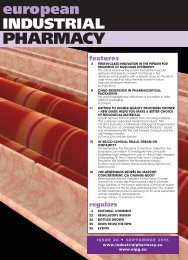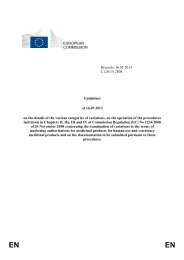PHARMACY
eip31-dec16
eip31-dec16
You also want an ePaper? Increase the reach of your titles
YUMPU automatically turns print PDFs into web optimized ePapers that Google loves.
FORMULATION TECHNOLOGY CAN ENABLE ORAL DELIVERY OF NEW GENERATION MEDICINES<br />
Fi gure 1<br />
continued<br />
1 2 3 4<br />
Tablet core<br />
ColoPulse coating<br />
Figure 1. ColoPulse technology. 1. In an environment where pH is below threshold pH for polymer dissolution,<br />
medium does not penetrate, no effect. 2. In an environment where pH is above threshold pH for polymer<br />
dissolution, medium penetrates film coat and initiates swelling of disintegrant. 3. Swelling of disintegrant develops<br />
cracks in polymer coat, accelerates polymer coat dissolution. 4. Dissolution of drug from core at target site.<br />
failure of delivery. ColoPulse<br />
coating is designed to improve the<br />
rate of dissolution of pH-dependent<br />
polymer once the appropriate pH<br />
environment (desired site of<br />
delivery) is encountered and offer<br />
true pulsatile release 58 .<br />
The ColoPulse coating uses<br />
methacrylic acid–methyl<br />
methacrylate copolymer (1:2) but<br />
the pH-responsiveness is enhanced<br />
by the incorporation of a swelling<br />
disintegrant (croscarmellose<br />
sodium) in the coating. Once the<br />
pH at which the polymer starts to<br />
dissolve is encountered, fluid<br />
reaches the disintegrant particles<br />
which can then swell and promote<br />
the formation of cracks in the<br />
polymer film which allows fluid<br />
penetration into the coat and<br />
encourages rapid polymer<br />
dissolution 58 (see Figure 1).<br />
The level of disintegrant<br />
employed is such that it does not<br />
offer opportunity to provide a<br />
pathway of closely neighbouring<br />
particles that would offer a ready<br />
pathway for fluid penetration to the<br />
tablet core prior to polymer<br />
dissolution initiating. This is<br />
described as a non-percolating<br />
lattice, with the disintegrant amount<br />
being below the percolation<br />
threshold above which its typical<br />
disintegrant properties would<br />
dominate 59 .<br />
The core tablet composition can<br />
influence the performance of the<br />
ColoPulse technology. The core is<br />
required to have some degree of<br />
swelling itself; including a watersoluble<br />
excipient, glucose,<br />
impaired pulsatile release<br />
performance compared with having<br />
slightly swelling microcrystalline<br />
cellulose in the core. Alkaline or<br />
acidic core tablet ingredients also<br />
impaired pulsatile performance. An<br />
acidic excipient, citric acid,<br />
prevented drug release and alkaline<br />
excipients, sodium bicarbonate or<br />
sodium benzoate, reduced the time<br />
to drug release, which might<br />
manifest as premature drug<br />
delivery in vivo 60 . A barrier subcoat<br />
(e.g. a neutral polymer such as low<br />
viscosity hydroxypropyl methyl<br />
cellulose) may be required in the<br />
case of active ingredients or<br />
excipients that affect the pulsatile<br />
performance of the ColoPulse<br />
coating 60 .<br />
The ColoPulse technology was<br />
originally validated in human<br />
volunteers and shown to release<br />
drug in the ileo-colonic region<br />
independent of transit times and<br />
once pH 7.0 environment is<br />
encountered 61 . It was found to<br />
perform in a comparable way in the<br />
disease-state in patients with<br />
Crohn’s disease 62 . This robustness<br />
is important as small intestine<br />
transit time is prolonged in patients<br />
with active Crohn’s disease or<br />
ulcerative colitis compared to<br />
healthy subjects or to patients with<br />
quiescent disease 63 . ColoPulse<br />
tablets also showed no sensitivity<br />
to food other than that expected<br />
from the known effect of food on<br />
GI transit time 62 .<br />
The feasibility of the application<br />
of ColoPulse to newer therapies<br />
employed in the treatment of IBD<br />
possibly enabling the oral delivery<br />
of the anti-TNF monoclonal<br />
antibody infliximab for topical<br />
effect in the colon has been<br />
demonstrated. A stable tablet<br />
dosage form with required robust<br />
pH-dependent drug release, having<br />
a profile compatible with colonic<br />
delivery, was produced 64 .<br />
COLAL<br />
COLAL is a microflora-activated<br />
delivery system that uses glassy<br />
1<br />
european INDUSTRIAL <strong>PHARMACY</strong> December 2016 • Issue 31<br />
11





